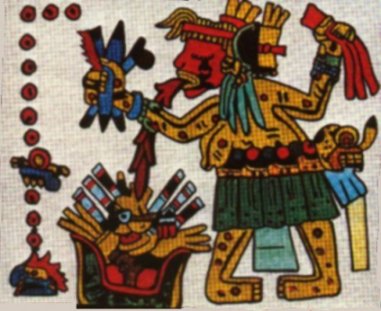The Aztec goddess Tlazolteotl
From the Codex Vaticanus B, Vatican Library, Rome
(Photo of a facsimile of 1898. Thames Hudson Archive)
When Cortez saw the flourishing Aztec city Tenochtitlan for the first time, he was impressed by its beauty and its inconceivable wealth and luxury. The medical care and the hygiene facilities in this Aztec city were also exemplary. Cortez reports: 'We found houses which were apothecaries, where you could buy prepared healing juices, salves and plasters for wounds.'
When the Spaniards withdrew in 1521, they left behind a city which was destroyed and violated; the inhabitants had almost been wiped out. In the 'pious anger' of their calling, the Spaniards destroyed almost all evidence and records of the natural religion of the Aztecs. Only very little material was left, and it has to be interpreted with great care today.
 In spite of the cruelty of its human sacrifices, the Aztec faith appears to have been based on a way of thinking which was rooted in nature.
In spite of the cruelty of its human sacrifices, the Aztec faith appears to have been based on a way of thinking which was rooted in nature.
The goddess Tlazolteotl is portrayed as the life-giving earth mother and goddess of fertility, but at the same time as the cruel, disease-bringing goddess of insanity. She takes possession of a person, penetrates him and causes him to fall in convulsions. This picture shows the goddess with the symptoms which she gives the people who are affected by the disease. The contorted face with the streaming eyes, the bent, twisted limbs and the mouth which is foaming and spitting blood are the tell-tale signs of epilepsy. In addition, the goddess is holding in one hand maize cobs as a symbol of life, and in the other hand a rattle, which was a ritual instrument for the dance of fertility, but was also a symbol of the scourge of illness.
--- close this window ---